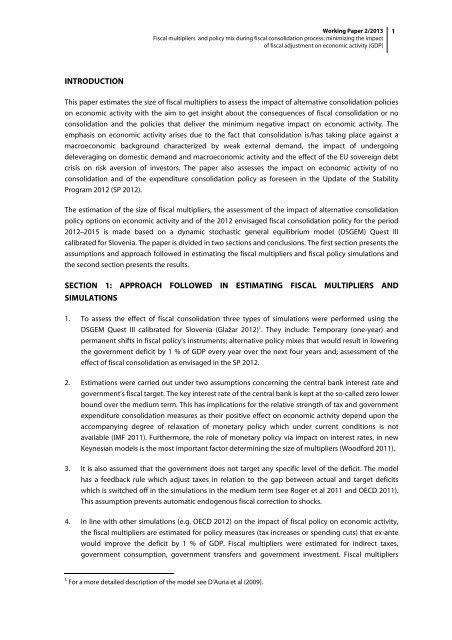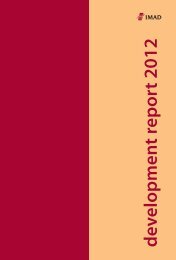Gonzalo C. Caprirolo and Marko Glažar Fiscal multipliers ... - UMAR
Gonzalo C. Caprirolo and Marko Glažar Fiscal multipliers ... - UMAR
Gonzalo C. Caprirolo and Marko Glažar Fiscal multipliers ... - UMAR
You also want an ePaper? Increase the reach of your titles
YUMPU automatically turns print PDFs into web optimized ePapers that Google loves.
Working Paper 2/2013<br />
<strong>Fiscal</strong> <strong>multipliers</strong> <strong>and</strong> policy mix during fiscal consolidation process: minimizing the impact<br />
of fiscal adjustment on economic activity (GDP)<br />
1<br />
INTRODUCTION<br />
This paper estimates the size of fiscal <strong>multipliers</strong> to assess the impact of alternative consolidation policies<br />
on economic activity with the aim to get insight about the consequences of fiscal consolidation or no<br />
consolidation <strong>and</strong> the policies that deliver the minimum negative impact on economic activity. The<br />
emphasis on economic activity arises due to the fact that consolidation is/has taking place against a<br />
macroeconomic background characterized by weak external dem<strong>and</strong>, the impact of undergoing<br />
deleveraging on domestic dem<strong>and</strong> <strong>and</strong> macroeconomic activity <strong>and</strong> the effect of the EU sovereign debt<br />
crisis on risk aversion of investors. The paper also assesses the impact on economic activity of no<br />
consolidation <strong>and</strong> of the expenditure consolidation policy as foreseen in the Update of the Stability<br />
Program 2012 (SP 2012).<br />
The estimation of the size of fiscal <strong>multipliers</strong>, the assessment of the impact of alternative consolidation<br />
policy options on economic activity <strong>and</strong> of the 2012 envisaged fiscal consolidation policy for the period<br />
2012–2015 is made based on a dynamic stochastic general equilibrium model (DSGEM) Quest III<br />
calibrated for Slovenia. The paper is divided in two sections <strong>and</strong> conclusions. The first section presents the<br />
assumptions <strong>and</strong> approach followed in estimating the fiscal <strong>multipliers</strong> <strong>and</strong> fiscal policy simulations <strong>and</strong><br />
the second section presents the results.<br />
SECTION 1: APPROACH FOLLOWED IN ESTIMATING FISCAL MULTIPLIERS AND<br />
SIMULATIONS<br />
1. To assess the effect of fiscal consolidation three types of simulations were performed using the<br />
DSGEM Quest III calibrated for Slovenia (<strong>Glažar</strong> 2012) 1 . They include: Temporary (one-year) <strong>and</strong><br />
permanent shifts in fiscal policy’s instruments; alternative policy mixes that would result in lowering<br />
the government deficit by 1 % of GDP every year over the next four years <strong>and</strong>; assessment of the<br />
effect of fiscal consolidation as envisaged in the SP 2012.<br />
2. Estimations were carried out under two assumptions concerning the central bank interest rate <strong>and</strong><br />
government’s fiscal target. The key interest rate of the central bank is kept at the so-called zero lower<br />
bound over the medium term. This has implications for the relative strength of tax <strong>and</strong> government<br />
expenditure consolidation measures as their positive effect on economic activity depend upon the<br />
accompanying degree of relaxation of monetary policy which under current conditions is not<br />
available (IMF 2011). Furthermore, the role of monetary policy via impact on interest rates, in new<br />
Keynesian models is the most important factor determining the size of <strong>multipliers</strong> (Woodford 2011).<br />
3. It is also assumed that the government does not target any specific level of the deficit. The model<br />
has a feedback rule which adjust taxes in relation to the gap between actual <strong>and</strong> target deficits<br />
which is switched off in the simulations in the medium term (see Roger et al 2011 <strong>and</strong> OECD 2011).<br />
This assumption prevents automatic endogenous fiscal correction to shocks.<br />
4. In line with other simulations (e.g. OECD 2012) on the impact of fiscal policy on economic activity,<br />
the fiscal <strong>multipliers</strong> are estimated for policy measures (tax increases or spending cuts) that ex-ante<br />
would improve the deficit by 1 % of GDP. <strong>Fiscal</strong> <strong>multipliers</strong> were estimated for indirect taxes,<br />
government consumption, government transfers <strong>and</strong> government investment. <strong>Fiscal</strong> <strong>multipliers</strong><br />
1 For a more detailed description of the model see D'Auria et al (2009).

















